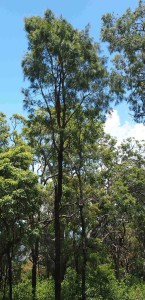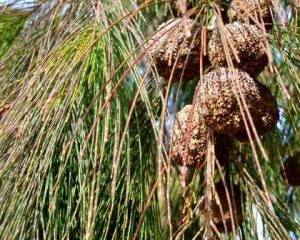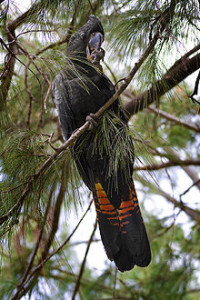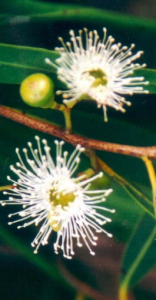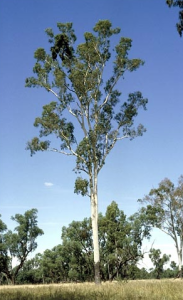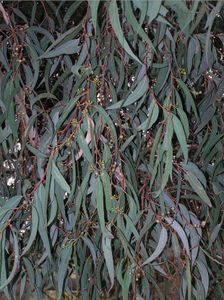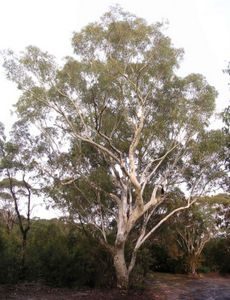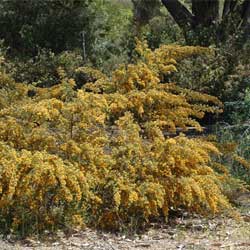Allocasuarina tortulosa (Forest Oak)
Form: Tree 10 to 20 metres tall.
Aspect: Full sun/Filtered sun.
Soil/Conditions: Adaptable/Well-drained.
Description:
Medium to large tree in Eucalypt forests.
Corky bark and needle-like “leaves”.
Large woody seed come up to 4cm long.
A food source for the glossy black cockatoo.
Prefers soil with at least some good drainage.
Fast growing and hardy.
Family: Casuarinaceae
Special features:
Good windbreak plant.
Glossy black cockatoo feeding tree.
Male and female flowers on separate plants.
Fallen needles for plant-excluding mulch.
Aboriginal food and tool source.
Aotus lanigera (Woolly Aotus)
Form: Shrub 1-1.5 metre tall & 1 metre wide
Soil: Adaptable
Aspect: Full sun/Filtered Sun
Description:
Sprawling, dense shrub.
Common in moister wallum areas.
Yellow pea flowers cover ends of branches.
Occurs naturally in sandy heath areas.
Family: Fabaceae
Special Features:
Good seaside plant
Similar form to coastal rosemary.
Excellent small coastal garden shrub
Corymbia tesselaris (Moreton Bay Ash)
Form: Tree to 30 metres tall
Aspect: Full sun
Conditions: Adaptable/ Well-drained
Description:
Open drooping habit.
Deciduous perennial.
Green, pendulous leaves to 18 cm.
White flowers to 15 mm in Summer.
Light brown woody capsules to 11 mm.
Family: MYRTACEAE
Special Features:
Attracts birds, especially Lorikeets.
Single white trunk with grey bark at base.
Branches widely at height.
Salt spray tolerant
Dodonaea triquetra (Forest Hop Bush)
Form: Open shrub to 3m tall
Aspect: Full sun
Conditions: Stony clay or sandy soils, amongst boulders
Description:
Tiny flowers winter to spring.
Papery 3-wing fruit to 15mm
Can be green pink or purple
Male and female separate plants
Family: SAPINDACEAE
Eucalyptus racemosa (Scribbly Gum)
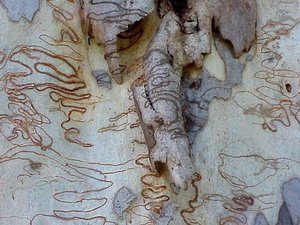
Form: Tree 15-20m on deep sandy soil.
Aspect: Full Sun / Semi-Shade
Soil/Conditions: Coastal lowlands
Description:
Leaves alternate, drooping blue-green, 19cm x 1.5cm. Not to be confused with Eucalyptus haemastoma, with broader and shorter leaves.
White flowers form between August and September.
Life expectancy > 100 years.
Family: Myrtaceae
Natural Habitat:
Usually on coastal lowlands, but sometimes inland and at higher altitudes.
Special Features:
Bark white, but marked with the “scribbles” of insect larvae
Attracts fauna when in flower for its nectar production. Foliage is browsed by Koalas, however not as readily as E. haemastoma. Very old trees can develop hollow logs which are utilised by a wide range of Australian fauna. Isolated plantings may fail to attract the characteristic Scribbly Gum Moth.
Pultenaea villosa (Hairy Bush Pea)
Form: Shrub 1 t0 1.5 metres tall
Aspect: Full sun
Soil / Conditions: Adaptable
Description: Rounded Shrub
Flowering in Autumn and Spring
Yellow and orange pea flowers.
Prune of a more compact or smaller plant.Family: Fabaceae
Family: Fabaceae
Special Features:
Bird attracting
Flowers produce nectar which is bush tucker.
Fantastic small coastal garden shrub.
Suited to a well-drained sunny position.
